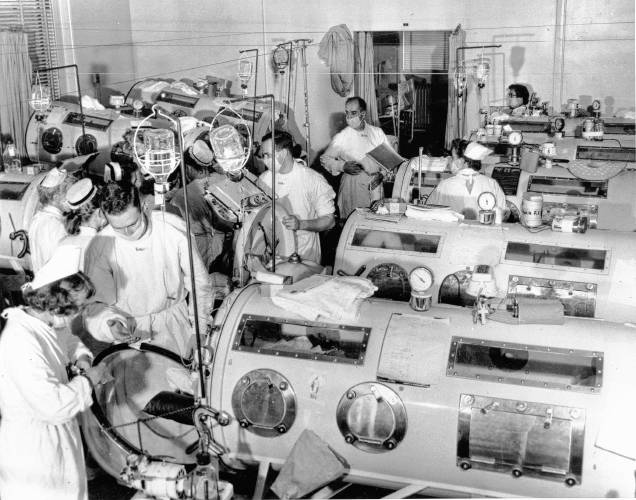Opinion: The anti-vaccine epidemic

This is a scene in the emergency polio ward at Haynes Memorial Hospital in Boston on Aug. 16, 1955. The critical patients are lined up close together in iron lung respirators so that a team of doctors and nurses can give fast emergency treatment as needed. AP
| Published: 01-10-2025 4:00 PM |
Jane Hunt of Concord is formerly an NHTI English professor, actor and disabilities advocate.
I remember how hot it was that summer; the heat, and all the thunderstorms. It wasn’t lightning and thunder that kept me indoors those sweltering days, though. It was Grammie.
Though long retired when I knew her, she’d worked as a practical nurse earlier in life and prided herself on the skills and knowledge that training afforded her. In the spring and summer of 1955, my grandmother called on this training when looking after me while my parents worked in Boston.
In Massachusetts, that summer differed sharply from the one before. Gone were the endless games of red-rover, hide-and-seek, and tag. Marbles, jacks, and jump-ropes lay abandoned; dodge-balls disappeared. The motley throng of kids who wrangled up and down our city block and in and out of each other’s kitchens had vanished.
In those days, the world of grown-ups barely touched the world of kids; we might have lived on different planets. Current events were confined to Papa’s newspaper and Mom’s half-hour of John Cameron Swayze before Wyatt Earp, I Love Lucy, and Father Knows Best overtook our little black-and-white TVs of an evening.
As a result, I was both mystified and mad when Grammie imposed this strange new regime of staying indoors all the time, made worse by her infuriating refusal to let me invite Carol or Linda over to play dolls or to dress up.
I complained, of course. Even if I hadn’t been too young to grasp the threat that Grammie feared, I wouldn’t have believed it could touch me. It wasn’t until Mary Margaret, three doors up the street, came to yell from the sidewalk to anyone within earshot that I began to understand.
I’d never seen Mary Margaret like this before. She was a year or two ahead of me in school, and I secretly thought her bossy. Yet here she was at the edge of our driveway, distraught, crying, yelling, caught three ways among grief, rage, and fear.
Article continues after...
Yesterday's Most Read Articles
“My brother’s got it,” she choked out to anyone who might hear her. “Joey. He’s got polio.”
Joey, 17, old enough to drive and star of his high school football team, played no role in my grade-school life. We all knew he’d soon move beyond our ken, going to work or maybe even to college. He’d leave us behind and turn into a grown-up. But in that moment, he was still Mary Margaret’s big brother, her champion in our little-kid disputes, and maybe the real source of that cockiness I found so annoying in Mary Margaret.
It wasn’t until the dread contagion abated that I was allowed to enter Mary Margaret’s home again. There Joey lay, imprisoned in his iron lung. Only his head was visible. The rest of his once-athletic body lay encased in a vast metal tube that emitted the ceaseless mechanized wheeze that operated his breathing for him.
This, I finally grasped, was polio. And this – Joey’s iron lung – was what polio threatened.
Not, just so you understand, like Mitch McConnell’s polio, though that’s not to minimize whatever McConnell endured and continues to endure from his decades-old infection. And nothing at all like the week-long cold-like symptoms that then disappear, leaving no trace behind. No, Joey’s polio meant he would spend the remainder of his life, less than two years, as it happened, in that iron lung.
We would later learn that Joey was one of nearly 4,000 Massachusetts victims of polio that long-ago summer, nearly 2,800 of them involving some level of paralysis. In those terrifying months before the Salk vaccine came on the market, there was no vaccine, no treatment, and no cure. Worse: there was no special ed back then for kids who sustained permanent damage from polio or any other ailment. Classmates would disappear overnight, gone from morning roll call, never to be seen or heard from again.
The situation was impossible; schools had stairs. Their classrooms often had bolted-down desks with attached seats. How do you wrestle a leg brace, much less a wheelchair, into such a set-up? The notion that a student with significant disabilities could be accommodated and enabled to attend school had yet to dawn on public awareness. It’s possible that polio’s far-reaching mass infection helped spark such awareness and begin raising long-overdue questions.
My family moved not long after this pandemic, out to one of Boston’s far-flung suburbs. I gradually lost touch with my old playmates. It was a different school gym where I lined up for my first dose of the Salk vaccine. It would never have occurred to me or to my parents to question or refuse this free, thoroughly-tested, public benefit. I had seen first-hand and close-up what such a refusal might cost me.







 Opinion: Trumpism in a dying democracy
Opinion: Trumpism in a dying democracy Opinion: What Coolidge’s century-old decision can teach us today
Opinion: What Coolidge’s century-old decision can teach us today Opinion: The art of diplomacy
Opinion: The art of diplomacy Opinion: After Roe: Three years of resistance, care and community
Opinion: After Roe: Three years of resistance, care and community
